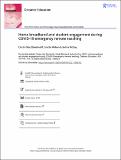Files in this item
Home broadband and student engagement during COVID-19 emergency remote teaching
Item metadata
| dc.contributor.author | Mac Domhnaill, Ciarán | |
| dc.contributor.author | Mohan, Gretta | |
| dc.contributor.author | Mccoy, Selina | |
| dc.date.accessioned | 2022-09-20T14:30:07Z | |
| dc.date.available | 2022-09-20T14:30:07Z | |
| dc.date.issued | 2021-11-03 | |
| dc.identifier | 281369498 | |
| dc.identifier | 8c78cd81-299f-4c8d-812c-6f627574e630 | |
| dc.identifier | 000714273600001 | |
| dc.identifier | 85118575033 | |
| dc.identifier.citation | Mac Domhnaill , C , Mohan , G & Mccoy , S 2021 , ' Home broadband and student engagement during COVID-19 emergency remote teaching ' , Distance Education , vol. 42 , no. 4 , pp. 465-493 . https://doi.org/10.1080/01587919.2021.1986372 | en |
| dc.identifier.issn | 0158-7919 | |
| dc.identifier.other | crossref: 10.1080/01587919.2021.1986372 | |
| dc.identifier.other | ORCID: /0000-0002-9869-7103/work/119628618 | |
| dc.identifier.uri | https://hdl.handle.net/10023/26040 | |
| dc.description | This research is supported by the Economic and Social Research Institute’s Electronic Communications Programme, jointly funded by the Department of Communications, Climate Action and the Environment and the Commission for Communications Regulation in Ireland. | en |
| dc.description.abstract | During the academic year 2019–2020, school buildings worldwide closed in response to the COVID-19 pandemic, necessitating a rapid shift to distance education. This study assessed the influence of high-speed broadband availability on student engagement with distance learning during this period in Ireland. Employing data from a representative sample of 206 secondary schools, student engagement as perceived by school principals was estimated to have been more adversely affected among schools located in areas with lower coverage of high-speed broadband. This may be partly explained by a lower probability of poorer student engagement among schools that deployed live online video teaching. While the costs and benefits must be considered, these findings may support the case for government intervention to provide greater equity in access to high-speed broadband. Where distance learning is required in future, secondary teachers should be supported in the use of live online teaching to better foster student engagement. | |
| dc.format.extent | 29 | |
| dc.format.extent | 3431821 | |
| dc.language.iso | eng | |
| dc.relation.ispartof | Distance Education | en |
| dc.subject | Distance education | en |
| dc.subject | Online learning | en |
| dc.subject | Secondary education | en |
| dc.subject | Broadband | en |
| dc.subject | COVID-19 | en |
| dc.subject | L Education (General) | en |
| dc.subject | NDAS | en |
| dc.subject | NIS | en |
| dc.subject.lcc | L1 | en |
| dc.title | Home broadband and student engagement during COVID-19 emergency remote teaching | en |
| dc.type | Journal article | en |
| dc.contributor.institution | University of St Andrews. School of Economics and Finance | en |
| dc.identifier.doi | https://doi.org/10.1080/01587919.2021.1986372 | |
| dc.description.status | Peer reviewed | en |
This item appears in the following Collection(s)
Items in the St Andrews Research Repository are protected by copyright, with all rights reserved, unless otherwise indicated.

